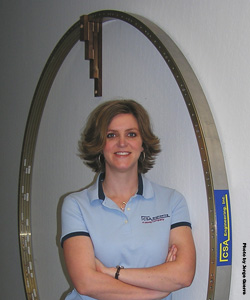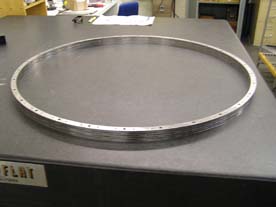Meet the IBEX Team: Emily Fowler

Project Engineer Emily Fowler and her team at CSA Engineering, a Moog Company, are a little like superheroes for spacecraft. When testing reveals that a rocket's vibrations might damage a spacecraft on its ride into space, they swoop in to save the day by creating custom vibration isolation systems to make the launch less bumpy.
Right now the team is working on "rescuing" the IBEX spacecraft from potentially harmful shaking by crafting a device called a SoftRide ShockRing to cushion and keep it separate from the rocket. Emily is the lead engineer for the design of IBEX’s ShockRing. "A ShockRing is a whole spacecraft isolation system," Emily said. "We're going to help protect the satellite during launch."
Emily and her team have been working nights and weekends to complete the design, construction, and testing of the ShockRing in an accelerated eight week schedule. The process normally takes up to four months.
"We’re glad to be part of the IBEX mission," Emily said. "We are excited about this design, and really think it’s going to serve IBEX well. It is not just my work, but the work of many dedicated engineers who have gone above and beyond what would usually be a four–month program and squished it down to eight weeks. It’s taken a lot of dedication. I appreciate the confidence that members of the IBEX team have put into CSA to be of service to the mission."
Watching the ShockRing successfully protect the spacecraft during launch is the most satisfying element of Emily’s work. "Seeing things launch, and knowing that we did our job, and that we’re sending something up there in space with a nice smooth ride, and watching it go is the best part of my job," Emily said. "Being there from when we get a problem and we take [the solution] from an idea to fruition, and seeing it installed and launching is great."
Emily loves that projects she designs end up outside Earth’s atmosphere. "I get to help launch stuff into space – that's just cool! When you [work on a project] from start to finish, you get to do and see a lot and learn a lot," she said.
Emily grew up in California, where she was inspired by both of her grandfathers’ skills in mathematics and tinkering. "I think probably both my grandfathers [inspired me] because one did numbers, and has always been interested in how things work, and the other one was in the Navy and was in mechanical repair and could fix any machine even if he had never seen it before," she said.
Early on, Emily knew she wanted to work in the space industry, although her ideas about the ideal job evolved over time. "My mother told me that when I was five, I said that I wanted to be an astronaut. I kept that through!" she said. "When I was in college, I realized I’d rather work around the periphery of [space exploration], but not necessarily go in that direction [of becoming an astronaut]."
Although she did not actively pursue a place in the astronaut corps, Emily says she would jump on a shuttle in a heartbeat if she were asked. "If they ever need someone to go up there [on the space shuttle] with [the ShockRing], I'd be fine with going."
In college at the University of California, Davis, Emily studied mechanical and aerospace engineering. She earned a master’s degree from San Jose State University, where she analyzed data from a student satellite project. She advises current engineering students to think broadly about a career path, and also to be inquisitive. "Don't be too narrow in your focus of what you think you want to do, because there are a lot of ways to get where you want to go," she said. "And ask questions. Engineers love it when you ask questions!"
While in school, the sheer number of parts needed to build something to go to space surprised Emily. "When you look at a rocket from the outside, it looks like a big white tube when you're 5 years old," she said. "You don’t realize just how many pieces there are that have to come together before you can launch."
After college, Emily worked for a company that creates the software NASTRAN, the NASA Structural Analysis Tool, which she currently uses at CSA Engineering. Emily uses this software to analyze data to help better design SoftRide systems, a product she thinks almost every satellite should have in the future. "What I’d like to see is our type of system being baselined [included on every mission from the beginning] because you are going to be able to get a lot more stuff up into space if you can give it a gentler ride," she said.
Whenever a challenge arises during her workday, Emily feels confident that her close–knit colleagues will pitch in to get the job done. "When I started, I was employee number 24, and now we're up to 54 people, so there's always a feeling of family and a feeling of team," she said. "There's always support when we hit challenges, and when we come against something, we know there will always be people to help us and back us up. People are always asking, 'What's going on with IBEX?' and 'What do you need?' so we can work to meet the customer's needs."
When she is not at work saving spacecraft from the forces of vibrating rockets, Emily enjoys scrapbooking, reading, camping, bike riding with her husband and son, and volunteering at her son’s school one day a week.
Her son’s creativity keeps her inspired. "My 7–year old son [inspires me] because he has an imagination that boggles my mind, and likes to play on software that I use for work," she said. "He will design on my software, and his enthusiasm for those tools and engineering is refreshing. He says he is going to build Transformers, 'but for real'."
With a gentler ride and a little inspiration, who knows what Emily and her team will be able to send into space in the future — maybe even "real" superheroes, like Transformers or even aerospace engineers!
